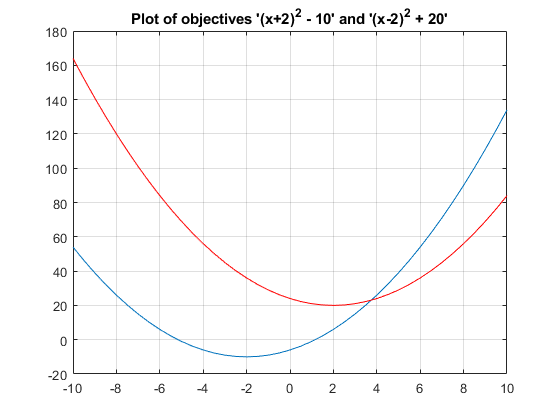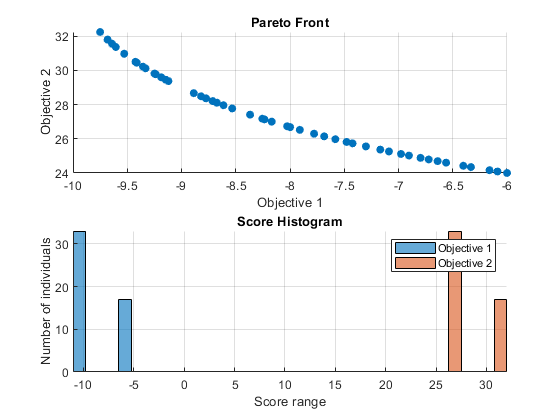使用遗传算法进行多目标优化
此示例显示如何使用多目标遗传算法函数 gamultiobj 在 Global Optimization Toolbox 中执行多目标优化。
简单的多目标优化问题
gamultiobj 可用于解决多变量多目标优化问题。这里我们要最小化两个目标,每个目标都有一个决策变量。
min F(x) = [objective1(x); objective2(x)]
x where, objective1(x) = (x+2)^2 - 10, and
objective2(x) = (x-2)^2 + 20% Plot two objective functions on the same axis x = -10:0.5:10; f1 = (x+2).^2 - 10; f2 = (x-2).^2 + 20; plot(x,f1); hold on; plot(x,f2,'r'); grid on; title('Plot of objectives ''(x+2)^2 - 10'' and ''(x-2)^2 + 20''');

这两个目标的极小值分别在 x = -2 和 x = +2。然而,在多目标问题中,x = -2、x = 2 以及 -2 <= x <= 2 范围内的任何解都同样最优。这个多目标问题没有单一的解。多目标遗传算法的目标是找到该范围内的一组解(理想情况下具有良好的分布)。该组解也称为帕累托前沿。帕累托前沿上的所有解都是最优的。
编写适应度函数
我们创建一个名为 simple_multiobjective.m 的 MATLAB® 文件:
function y = simple_multiobjective(x) y(1) = (x+2)^2 - 10; y(2) = (x-2)^2 + 20;
遗传算法求解器假定适应度函数将接受一个输入 x,其中 x 是一个行向量,其元素数量与问题中的变量数量一样多。适应度函数计算每个目标函数的值,并在单个向量输出 y 中返回这些值。
使用 gamultiobj 进行最小化
要使用 gamultiobj 函数,我们需要提供至少两个输入参量、一个适应度函数和问题中的变量数量。gamultiobj 返回的前两个输出参量是 X(帕累托前沿上的点)和 FVAL(X 处的目标函数值)。第三个输出参量 exitFlag 告诉您 gamultiobj 停止的原因。第四个参量 OUTPUT 包含有关求解器性能的信息。gamultiobj 还可以返回第五个参量 POPULATION,其中包含 gamultiobj 终止时的种群,以及第六个参量 SCORE,其中包含 POPULATION 终止时 gamultiobj 的所有目标的函数值。
FitnessFunction = @simple_multiobjective; numberOfVariables = 1; [x,fval] = gamultiobj(FitnessFunction,numberOfVariables);
gamultiobj stopped because it exceeded options.MaxGenerations.
求解器返回的 X 是一个矩阵,其中每一行都是目标函数帕累托前沿上的点。FVAL 是一个矩阵,其中每一行包含在 X 中相应点评估的目标函数值。
size(x) size(fval)
ans =
18 1
ans =
18 2
约束多目标优化问题
gamultiobj 可以处理具有线性不等式、等式和简单边界约束的优化问题。这里我们想对之前解决的简单多目标问题添加边界约束。
min F(x) = [objective1(x); objective2(x)]
xsubject to -1.5 <= x <= 0 (bound constraints)
where, objective1(x) = (x+2)^2 - 10, and
objective2(x) = (x-2)^2 + 20 gamultiobj 接受形式为 A*x <= b 的线性不等式约束、形式为 Aeq*x = beq 的线性等式约束和形式为 lb <= x <= ub 的边界约束。我们将 A 和 Aeq 作为矩阵传递,将 b、beq、lb 和 ub 作为向量传递。由于在这个例子中我们没有线性约束,我们将 [] 传递给这些输入。
A = []; b = []; Aeq = []; beq = []; lb = -1.5; ub = 0; x = gamultiobj(FitnessFunction,numberOfVariables,A,b,Aeq,beq,lb,ub);
gamultiobj stopped because it exceeded options.MaxGenerations.
X(每一行)中的所有解都将满足 options.ConstraintTolerance 中指定的容差范围内的所有线性和边界约束。但是,如果使用自己的交叉或变异函数,请确保新的个体在线性和简单边界约束方面是可行的。
添加可视化
gamultiobj 可以通过选项参量接受一个或多个绘图函数。此功能对于在运行时可视化求解器的性能很有用。可以使用 optimoptions 选择绘图函数。
这里我们使用 optimoptions 来选择两个绘图函数。第一个绘图函数是 gaplotpareto,它绘制每代的帕累托前沿(仅限于任意三个目标)。第二个绘图函数是 gaplotscorediversity,它绘制每个目标的分数多样性。这些选项作为最后一个参量传递给求解器。
options = optimoptions(@gamultiobj,'PlotFcn',{@gaplotpareto,@gaplotscorediversity});
gamultiobj(FitnessFunction,numberOfVariables,[],[],[],[],lb,ub,options);
gamultiobj stopped because it exceeded options.MaxGenerations.

向量化您的适应度函数
再次考虑先前的适应度函数:
objective1(x) = (x+2)^2 - 10, and objective2(x) = (x-2)^2 + 20
默认情况下,gamultiobj 求解器每次仅将一个点传递给适应度函数。然而,如果适应度函数被向量化以接受一组点并返回一组函数值,则可以加快解的速度。
例如,如果求解器需要在一次调用此适应度函数中评估五个点,那么它将使用大小为 5×1 的矩阵调用该函数,即 5 行 1 列(回想一下,1 是变量的数量)。
创建一个名为 vectorized_multiobjective.m 的 MATLAB 文件:
function scores = vectorized_multiobjective(pop)
popSize = size(pop,1); % Population size
numObj = 2; % Number of objectives
% initialize scores
scores = zeros(popSize, numObj);
% Compute first objective
scores(:,1) = (pop + 2).^2 - 10;
% Compute second objective
scores(:,2) = (pop - 2).^2 + 20;这个向量化的适应度函数版本采用具有任意数量点的矩阵 pop、pop 的行,并返回大小为 populationSize x numberOfObjectives 的矩阵。
我们需要指定适应度函数使用通过 optimoptions 创建的选项进行向量化。选项作为第九个参量传递。
FitnessFunction = @(x) vectorized_multiobjective(x);
options = optimoptions(@gamultiobj,'UseVectorized',true);
gamultiobj(FitnessFunction,numberOfVariables,[],[],[],[],lb,ub,options);
gamultiobj stopped because the average change in the spread of Pareto solutions is less than options.FunctionTolerance.